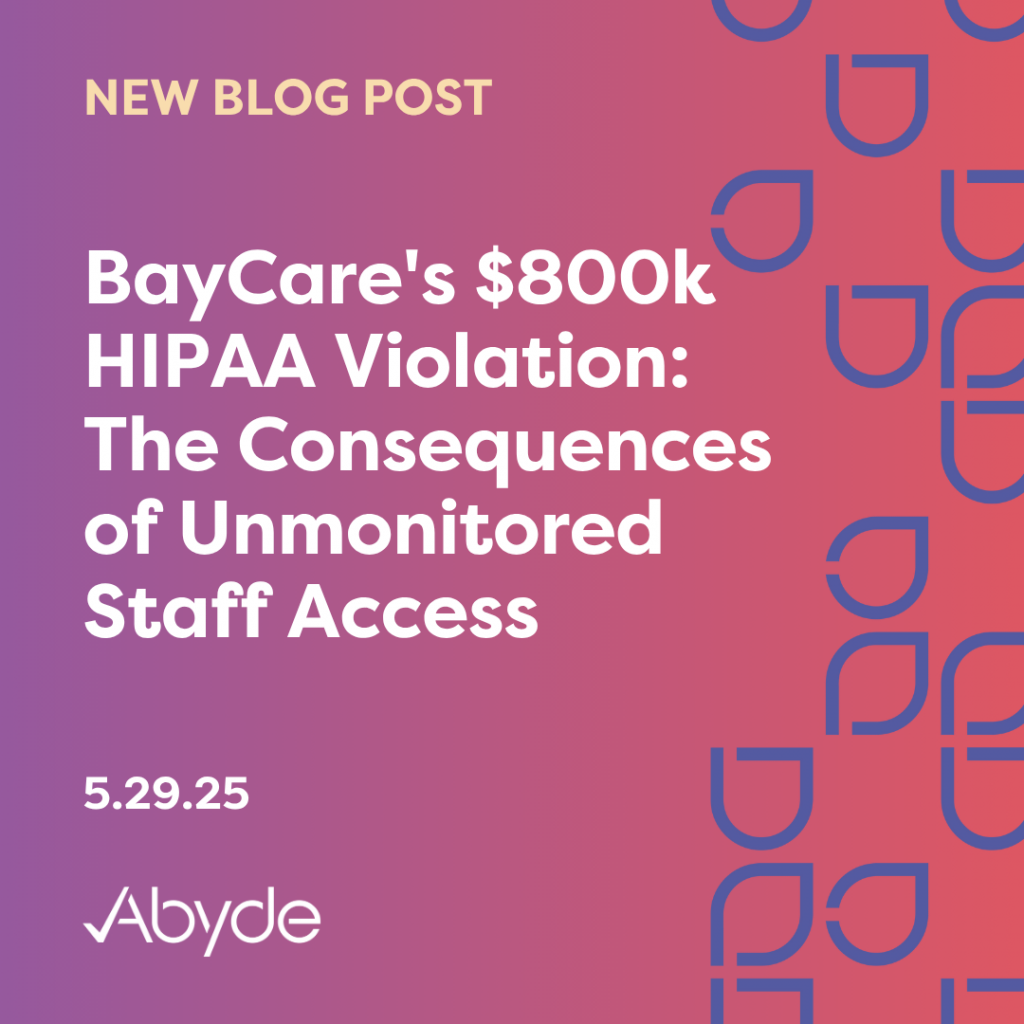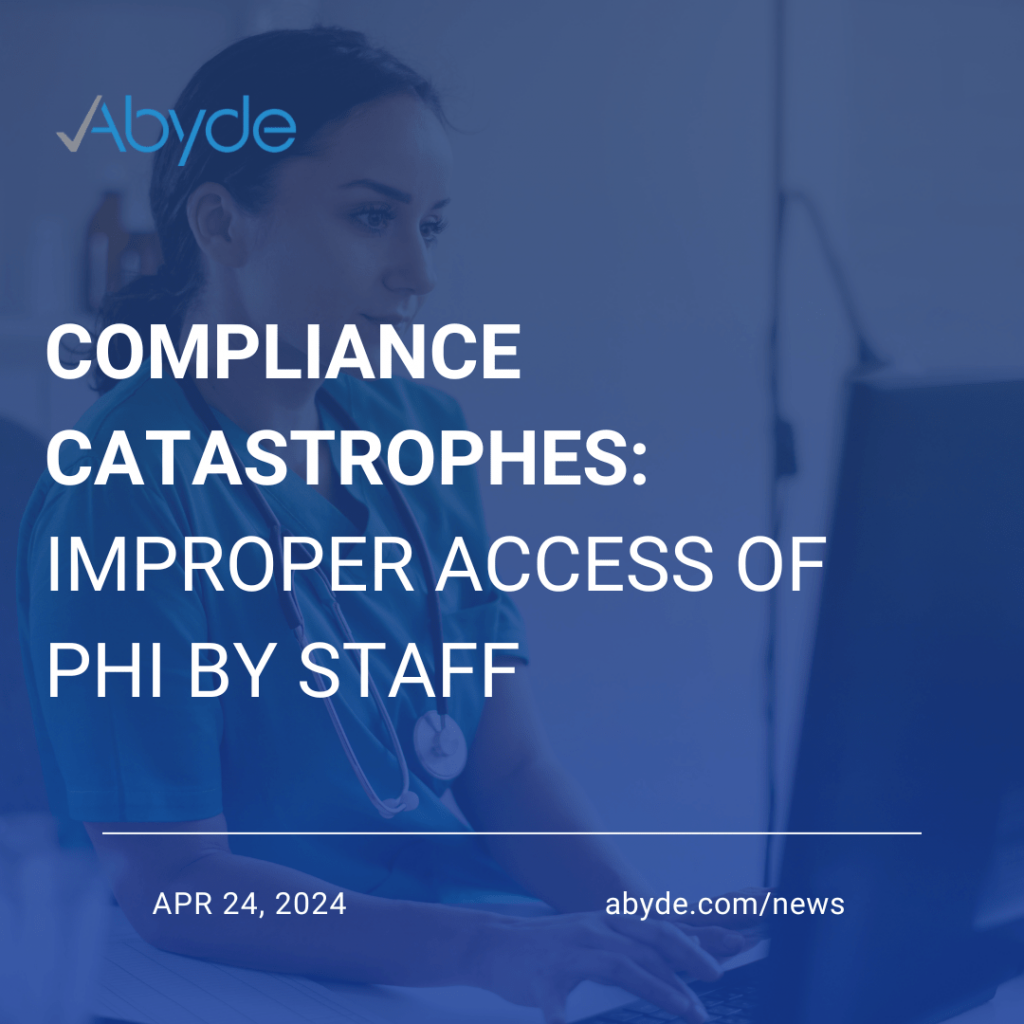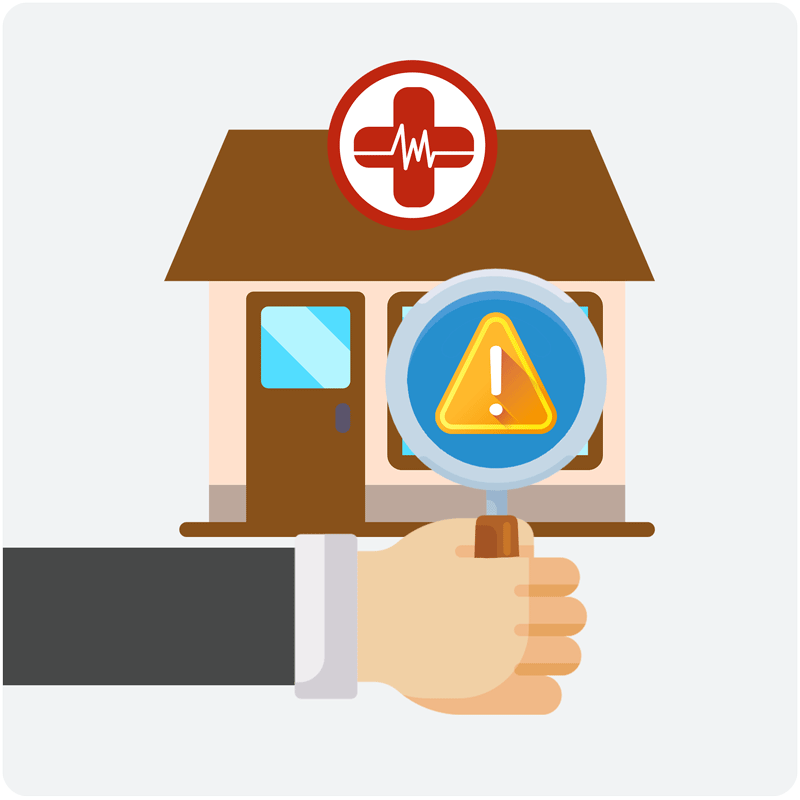May 29, 2025 A successful practice is built upon a strong foundation of well-trained and aware staff. Protecting patient data is a critical responsibility for healthcare staff. Data breaches involving Protected Health Information (PHI) can occur in many ways, but the foundation of security lies in a workforce committed to safeguarding it. A Florida healthcare provider, BayCare Health System, experienced the consequences of improper disclosure of PHI due to a complaint and a noncompliant staff member in the latest HIPAA fine. Acting Director of the Office for Civil Rights (OCR) Anthony Archeval commented on the importance of managing staff access, saying, “allowing unrestricted access to patient health information can create an attractive target for a malicious insider.” What Happened? In 2018, an unnamed complainant visited St. Joseph’s Hospital, a facility under the BayCare Health System, for an appointment. After treatment, she received communication from an unknown contact who sent the complainant photos of her medical records and a video of a BayCare associate scrolling through her file as well. This communication led to a complaint filed with the OCR. Several years of legal interactions and investigations by the OCR resulted in an $800,000 settlement six years later. After the investigation, it was found that BayCare failed to have procedures and policies for handling ePHI, failed to reduce risks, and did not review staff access. This nearly million-dollar fine resulted from a malicious insider, insufficient documentation, and an oversight of staff privileges. Reviewing staff access is vital for protecting patient data. By monitoring staff activity, you can ensure that PHI does not end up in the wrong hands. Additionally, when providing staff with access to PHI, confirm that access is necessary to complete essential job tasks. This falls under the Minimum Necessary Standard within the HIPAA Privacy Rule, which enforces that disclosed PHI is only shared for an authorized and required purpose. Staff must be thoroughly trained in their responsibilities before accessing PHI, and policies and procedures regarding handling PHI must be readily available for staff to review. While this situation did not lead to jail time, it is not unheard of in the medical field, so staff must also be aware of the consequences. Training and Monitoring Staff with Abyde Smart compliance solutions streamline training, policies and procedures, and monitoring access, creating a culture of compliance that protects your organization from malicious insiders. With an intelligent platform managing compliance, you can dynamically generate unique policies and procedures in seconds, automating this task without human error. Additionally, a centralized compliance hub allows staff to review documentation before working with patients and refer to it if there is any confusion. Access logs can also be found in this hub, which keeps staff accountable when they review patient PHI. With intelligent solutions, proactive compliance is made easy, encouraging staff to take their HIPAA responsibilities seriously. Speak with a compliance expert today to learn more about how compliance can be simplified for your practice.
Compliance Catastrophes: Improper Access of PHI by Staff
April 24, 2024 It’s hump day! As we get through this middle bump of the week, we’re still rolling our series, Compliance Catastrophes; real-ish world examples of nightmare scenarios! Today, we’re looking at you, healthcare workers and Business Associates! We know you do amazing work when taking care of patients, but keeping data secure is a part of building an awesome practice or business environment. When given the keys to keep Protected Health Information (PHI) safe, it doesn’t mean to open the treasure chest of data! When working in this field, you’re around a lot of sensitive information, and it’s vital to uphold your commitment to patients by keeping it confidential! We know it’s not all healthcare workers or their associates, but more people break this rule than you’d expect. We’re getting scientific! There was a recent study that highlighted over 400 employees inappropriately accessing PHI at a hospital, and many only stopped accessing unauthorized PHI due to being warned they were caught by email. It shouldn’t take being caught to change bad behavior! You know the drill – improperly accessing PHI is a breach of trust. But just to be safe, let’s see an example of what you should not do. Now, joining us today, you guessed it, is our unlucky friend, Catastrophe Cathy. PHI Peeking Cathy was at the front desk when a familiar face showed up for an appointment. An old friend from high school that she hasn’t seen in years! They chat for a little bit, and Cathy can’t help but wonder what brought this friend in. When she’s closing up, she can’t ignore the voice in the back of her head to go look. She falls for the temptation and searches for her friend’s medical information, curious about what brought her old friend into the practice. As she’s reading about her old friend, another employee notices what she’s doing. Cathy is embarrassed and ashamed, as well as she should be! She was breaching her old friend’s PHI. That information is strictly confidential, no matter how close they used to be. Real Life: Real FinesYou might think that a situation like this could never happen to you, but it happens often and there are severe consequences. Last year, the OCR fined Yakima Valley Memorial Hospital in Washington State due to some snooping security guards. Curiosity didn’t kill the cat, but did leave it with a hefty fine! Over 400 patients’ records were looked at and the hospital was charged with a pretty expensive bill: $240,000! To avoid snooping breaches, make sure all staff are properly trained on their roles and responsibilities. Access controls need to be monitored often, ensuring staff only have access to what pertains to their role. Additionally, make sure logs are reviewed, keeping your eyes open for any suspicious activity. We all deserve our health information to be secure, and healthcare workers and business associates are at the front lines of keeping it confidential. To learn more about common compliance catastrophes, email us at info@abyde.com and stay tuned for the next in our series on our social media!
City of New Haven Reaches HIPAA Settlement After Former Employee Steals Patient Information
October 30, 2020 Just when we thought the month was over, the Office for Civil Rights (OCR) decided to sneak one more HIPAA fine in at the last minute. Earlier today the OCR announced October’s FOURTH fine – this time with the City of New Haven, Connecticut who has agreed to pay a $202,400 fine and complete 2-year corrective action plan after violating the HIPAA Privacy and Security Rules. The 15th settlement of the year came as a result of HIPAA violation back in January 2017 that sounds almost like a TV drama. Back in 2017, the incident began when the New Haven Health Department notified the OCR that a former employee appeared to have accessed a file on a computer containing protected health information (PHI). After some OCR sleuthing, it was revealed that 8 days after being fired in July 2016, the same employee returned to the health department and logged into her old computer with still-active credentials (we’re picturing her with a large hat, sunglasses and a trench coat) and downloaded the PHI of 498 individuals to a USB drive. The malicious download included patient names, addresses, and other personal medical information. And as if this really was a binge-worthy TV show (grab the popcorn) the former employee then shared her login ID and password with an intern – who continued to do the dirty work for her. On top of the drama-filled breach, the OCR investigation also uncovered major gaps in the health department’s HIPAA program, including: We’ve seen a number of recent HIPAA settlements centering around improper access, but in this case the unauthorized access came as a result of the New Haven Health Departments’ failure to have proper employee offboarding procedures. The simplest task of deactivating the employee’s login credentials could have saved the organization a huge chunk of change, and kept 498 patients’ information better protected. You can never really predict when an employee will ‘go rogue’, and not having a termination system in place – or even just waiting a few days to disable access – can be a costly mistake. Having a comprehensive plan from an employee’s first day to their last is an important aspect of general operations, but especially your HIPAA compliance program. OCR Director Roger Severino said it best: “Medical providers need to know who in their organization can access patient data at all times. When someone’s employment ends, so must their access to patient records.”
Top 4 HIPAA Violations Your Practice Should Avoid
September 4, 2020 Even with everything else going on in the world today, HIPAA violations are still making headlines. While these news stories reinforce that the Office for Civil Rights (OCR) hasn’t let up on HIPAA enforcement, they also provide great examples of what not to do when it comes to your own practice. Based on these violations and recent OCR investigation data, we’ve compiled the top four types of violations investigated by the OCR: 1. Impermissible Uses & Disclosures The reigning champion of HIPAA violations over the past 5 years – impermissible uses or disclosures – covers any access, use, or sharing of protected health information (PHI) that is done in a manner not permitted under HIPAA and compromises the security or privacy of a patient’s sensitive information. Common culprits include: Having the right policies in place outlining the proper ways staff may use and disclose PHI is key to ensuring your practice doesn’t join the growing list of improper use violators. 2. Missing Physical, Technical and Administrative Safeguards HIPAA law requires practices to implement safeguards to ensure PHI is protected and secured. These safeguards include: Failing to implement key safeguards is what gets practice’s into trouble, which is why it is essential to perform in-depth as well as ongoing Security Risk Analyses in order to properly identify which safeguards are missing 3. Improper Access Your data library shouldn’t be fair game to every employee regardless of their role. Even if just glancing at a patient’s information, any access to patient information that is not necessary to complete a specific job function is a violation of HIPAA. With remote work becoming more and more common, we can expect improper access violations to rise as employees use data in less secure environments and with less supervision than there would be in a typical practice setting. Appropriate access is featured heavily in HIPAA, and it’s important to limit and document your access roles. It’s not just internal access to PHI that can get your practice into trouble. There are specific guidelines for providing patients with medical records as well, and while this may seem straightforward 51% of providers fail to comply with HIPAA Right of Access laws. Understanding what Patient Right of Access laws entail is important to keeping your patients happy and avoiding a problem with the OCR. 4. Violations of Minimum Necessary Requirement Less is more when it comes to sensitive health information. Only the minimum information necessary should be provided when PHI is requested, accessed, or disclosed. Violations of this requirement could include providing additional information such as previous medical conditions that may not pertain to the actual purpose of the task at hand. Having proper training and documented policies in place that define what information is considered necessary is an essential piece to protecting your patient’s information and steering clear of a HIPAA violation. A Violation is Just a Slap on the Wrist, Right? While a violation in any of these areas could be minor, a HIPAA violation fine ranges anywhere from a few hundred to a million dollars based on various factors such as: The biggest fine so far? $16 million in a single settlement. Monetary fines aren’t the only thing you have to worry about if you find yourself facing a HIPAA violation. Jail time and extensive corrective action plans involving extra oversight and administrative work are real possibilities if a violation is found. So How Can You Best Avoid a HIPAA Violation? Many HIPAA violations can be attributed to a lack of employee education on what’s required under federal law. Violations aren’t usually intentional or malicious, which is why it’s so important to create a culture of compliance within your organization and promote good habits. Keeping up with your HIPAA compliance program and staying updated on any changes to federal regulations is the best way to keep your patients’ information secure and avoid ending up as another HIPAA headline.
OCR Highlights Asset Log as Key HIPAA Recommendation
August 25, 2020 Earlier today, the Office for Civil Rights (OCR) sent out their seasonal Cybersecurity Newsletter on a very timely and relevant topic – the importance of keeping track of devices that contain electronic protected health information (ePHI). The OCR’s newsletter highlights two important things for independent practices: first, that having an asset log is the recommended method for tracking and thus safeguarding devices that contain ePHI, and second, that the OCR views practice’s lack of knowledge around where their devices are as a key area of concern. Part of the HIPAA Security Rule, practices are required to implement the necessary technical safeguards covered in the Security Risk Analysis (SRA) – including encrypting and securing their devices that contain sensitive ePHI. While an asset log isn’t directly required under HIPAA, the OCR highly recommends the creation and maintenance of an IT asset inventory to better understand where ePHI may be stored and strengthen overall compliance with these requirements. What does an Asset Log entail? We know it’s hard to keep tabs on everything within your practice, but when it comes to your devices keeping inventory is key. As the OCR’s newsletter highlights, the asset log should be a comprehensive list of all IT assets with corresponding descriptive information. The OCR notes that this list could include ALL devices, even those that don’t access ePHI directly, as they could contain ePHI unknowingly or be an entry point for cyberattackers to your network. Your list should include: When documenting these assets, Abyde recommends including all the following information: Additionally, it is important to regularly update your asset log as devices are moved around by location or by assigned staff members. Just like an SRA, your asset log should not be a ‘one and done’ project, and should instead be reviewed regularly. You should also track when devices are disposed of, as properly disposing of devices that contain ePHI is a common cause of HIPAA violations. No matter the size of your practice, creating and maintaining a thorough asset log isn’t an easy task. With a program like Abyde, our built in Asset Log covers all the OCR recommendations and then some – helping you track devices at high risk and making your IT inventory intuitive. Having the ability to access your asset log within a cloud-based solution like Abyde makes reviewing and updating inventory a breeze, and helps ensure you’re complying with all the right technical safeguards.
Recently Offboarded Staff? Don’t Forget About HIPAA Requirements
August 6, 2020 Many practices have an organized system for welcoming a new employee to the team. Usually, new staff is an exciting addition, and you’ve likely got your welcome bag, name tags and business cards at the ready. But, when it comes to the end of an employee’s life cycle at your practice – not uncommon in 2020 due to COVID-19 – the process may not be as exciting or as organized. The uncertainty that surrounds having to terminate an employee can be messy, leading to paperwork and processes being executed in haste. In this hurry, mistakes are often made leaving sensitive patient data exposed to unauthorized recipients. Even if you have the best intentions and think it’ll never happen to you, data breaches continue to surface stemming from improperly terminated access. Whenever you part ways with a former workforce member, full offboarding measures must be taken to ensure full protection of your practice as well as your patient’s data. The HIPAA Security Rule specifically details the required termination procedures in Section 142.308(a)(11) as the “formal, documented instructions for ending employment and closing off internal and external access.” This removal of access can be done by implementing the following offboarding actions: Even for former employees, documentation is still essential when it comes to HIPAA compliance. Your practice should keep all HIPAA training certificates on file for up to 6 years even if terminated. If a breach occurred prior to an employee’s termination, or an audit occurs even after termination, you will need to produce a copy of the training certificate to prove that each staff member was properly trained at the time. Other steps that should be taken on a regular basis to help improve the security within your practice as well as help ensure a smoother offboarding process include: You may have a system in place for offboarding, but if you’re a busy practice there’s no harm in waiting a month or two to make sure access is revoked, right? Well…not so much. Every day that your former staff still have access to PHI is not only another day of increased risk, but also a major concern if ever audited or investigated by the OCR. In fact, failing to properly implement these procedures when offboarding employees has been the catalyst for multiple HIPAA breaches. In 2018, a Colorado Hospital found themselves in a HIPAA violation costing them $111,400 after terminating an employee without proper offboarding. The employee was not removed from the hospital’s online-based scheduling calendar which contained PHI – ultimately allowing continued access to the PHI of almost 600 patients. Along with the former employee’s access, it was found that the medical center’s web-based scheduling calendar vendor also received access to PHI without the proper Business Associate Agreement in place. In response to this settlement OCR Director, Roger Severino emphasized that “This case underscores the need for covered entities to always be aware of who has access to their ePHI and who doesn’t.” Equally as important as staff is properly offboarding any vendors your practice worked with. If any of your vendors have any access to your practice both physically as well as electronically they must be properly removed when your work contract is terminated. Things like disabling remote access to servers from any accounts with administrative privileges are often overlooked and can be a huge risk for data breaches and HIPAA violations. In fact, having a proper Business Associate Agreement in place with these vendors puts them on the hook for removing access and returning or destroying any PHI they may have had or created on behalf of your practice. Having a comprehensive plan from the start to finish of an employee’s time at your practice will have a huge impact on ensuring the security of the sensitive patient information within your organization. While you most likely won’t have to deal with an employee gone rogue, being proactive and making certain that there are no loose ends when it’s time for a staff member to leave will help make the offboarding process seamless and stress-free.





